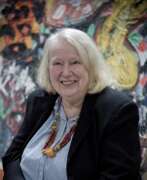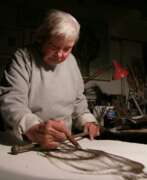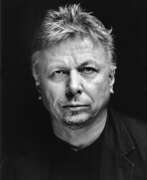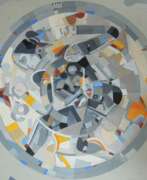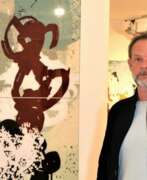Engravers 21st century


Jan Leth Aagensen was a Danish artist. He made his name as a lithographer and later became known for his sculptures.
Jan Leth's formal training took place at the Royal Danish Academy of Fine Arts under Professor Søren Hjort Nielsen from 1965 to 1969. His first exhibition took place in 1961 at Kunstnernes Forårudstilling (Spring Artists' Exhibition). He is a member of various art groups: Decembristerne, Kunstnersamfundet og Foreningen Danske Grafikere, the Association of the Royal Danish Academy of Fine Arts and the Association of Danish Painters Engravers.
Jan Leth has participated in various solo and group exhibitions, presenting paintings, sculptures, drawings, and installations in Denmark and abroad. He has received many honours and grants throughout his life. The Danish State gave him a lifelong economic grant in 1998. His work is represented in gallery collections in Denmark and internationally.


Franz Ackermann is a German media artist.
He studied at the Academy of Fine Arts in Munich and at the University of Fine Arts in Hamburg, lives and works in Berlin and Karlsruhe.
Franz Ackermann's work includes drawings, watercolors, murals, paintings and installations, which he complements with photographic works, projections and architectural models. His works deal with the themes of tourism, globalization and urbanism and reflect the social changes and political problems caused by increasing globalization.


Giuseppe Ajmone was an Italian painter and printmaker.
He studied painting at the Brera Academy of Fine Arts in Milan and in 1946 was one of the signatories of the Realist Manifesto, also known as "Oltre Guernica.
Ajmone painted both landscapes and still lifes as well as semi-abstract figures.
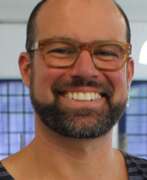

Luis M. Alonzo-Barkigia is a contemporary Mexican artist. He studied at the Malmö Academy of Art (Sweden) and at the University of Illinois at Chicago. He was awarded the UIC Presidential Fellowship, the Larsen Fellowship for Studio Arts.


Charles Arnoldi is an American painter, sculptor and printmaker.
In the early 1970s, the artist attracted attention for his wall-relief wood sculptures, such as Honeymoons in the collection of the Honolulu Museum of Art.
The use of wood remained a feature of Arnoldi's oeuvre, although, since the 1980s, he has often employed it in combination with other media. In the 1990s, Arnoldi's output changed radically. He began producing abstract paintings on canvas, first black and white, and later brightly colored.


Ugo Attardi was an Italian painter, sculptor and writer. Attardi moved from Genoa to Rome in the early 1950s, where he formed the group Forma 1 together with other artists. His sculpture of Ulysses is now permanently installed in Battery Park in New York


Daniel Authouart is a French painter, draughtsman and lithographer.
He studied at the École des Beaux-Arts in Rouen and lives and works in the same city. Authouart is known for his hyper-realistic paintings and lithographs on themes of modern life. He also created book bindings, posters and theater sets.


Tayeba Begum Lipi is a Bangladeshi artist and the co-founder and trustee of Britto Arts Trust. She has received Grand Prize at the 11th Asian Art Biennale, Bangladesh 2004. Lipi is a multimedia artist who has engaged in paintings, prints, installations and videos. Her works have been featured in notable group exhibitions, including the 54th Venice Biennale (2011) and Colombo Art Biennale (2012). She was also the commissioner for the Bangladesh Pavilion at the 54th Venice Biennale (2011).


Jonathan Borofsky is an American artist known for his public sculptures and installations that explore themes of human consciousness, individuality, and interconnectedness.
Borofsky studied at Carnegie Mellon University and Yale University. In the 1970s, he gained recognition for his conceptual and performance works, which often incorporated elements of language, text, and repetition.
In the 1980s, Borofsky began creating large-scale public sculptures, many of which feature human figures or silhouettes. One of his most famous works is "Molecule Man," a 100-foot-tall sculpture of three interconnected figures located in Berlin, Germany.
Borofsky's work has been exhibited in major museums and galleries around the world, including the Museum of Modern Art in New York, the Centre Georges Pompidou in Paris, and the National Museum of Contemporary Art in Seoul. He has also created public artworks in cities such as New York, Tokyo, and Tel Aviv.
In addition to his art, Borofsky is known for his interest in meditation and spirituality, which he often incorporates into his work. He has published several books on these topics.
Borofsky continues to live and work in Ogunquit, Maine, where he maintains a studio and creates new works of art.


Jason Brooks is a contemporary British artist known for his fashion illustrations and portraits. He was born in 1969 and studied at Chelsea School of Art and Central Saint Martins in London. His work has been published in publications such as Vogue, Elle and The New Yorker.
Jason Brooks has worked with fashion brands including Chanel, L'Oreal and Christian Dior. As well as commercial work, he has exhibited his work in galleries around the world, including the Saatchi Gallery in London and the Museum of Modern Art in Tokyo.


James Brown was an American-born painter active in Paris and Oaxaca, Mexico. He was most well known in the 1980s for his rough painterly semi-figurative paintings, bearing affinities to Jean-Michel Basquiat and East Village painting of the time, but with influences from primitive art and classical Western modernism. His work has taken on several styles over the years but maintains a hand-made look combining concerns of the modernist tradition with motifs and spiritual interests from tribal art. Much of his work is a non-realistic but contains depictions or signs of recognizable faces or objects. However, the line between representation and abstraction is often a difficult one in his work. Besides paintings Brown has also produced sculptures and series of prints at various points in his career, and in the 1990s started to heavily utilize collage.


Fran Bull is an American sculptor, painter, and print-maker living and working in Brandon, Vermont and Barcelona, Spain. Bull became known originally for her Photorealism paintings made in the mid 1970s and 80s. In the late 1980s, Bull’s art began to develop towards abstraction, or neo-abstract expressionism. Sparked by her newfound approach to painting, in the mid-1990s Bull began to explore other media. Since that time her artistic output has included performance art, sculpture, mixed media, and printmaking, as well as painting. She has been especially prolific in the area of printmaking. Bull has produced many diverse series of etchings that continue to be exhibited worldwide.


Volker Bußmann is a contemporary German artist known for his diverse and eclectic body of work. He explores various artistic genres, including landscape and figure painting, op-art, and printmaking. His artistry demonstrates a wide range of influences and styles, making him a versatile and dynamic artist. Bußmann's work may incorporate a combination of traditional and contemporary elements.


Arturo Carmassi was an Italian abstractionist painter, sculptor, and printmaker.
He studied at the Albertina Academy in Turin. Carmassi created many images, sculptures and engravings on metal and worked in lithography and silkscreen. He has participated in numerous exhibitions and biennales and is an internationally recognized sculptor.
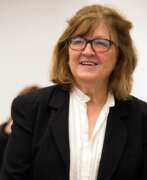

Vija Celmins is a Latvian-American artist. She is best known for her photorealistic paintings and drawings of natural and man-made objects.
Celmins and her family fled Latvia during World War II and eventually settled in the United States. She studied art at the John Herron School of Art in Indianapolis and later at the University of California, Los Angeles.
Celmins began her career as a painter in the 1960s, and by the 1970s she had developed her signature style of photorealism. She is known for her painstaking attention to detail, and her paintings and drawings often take months or even years to complete. Some of her most famous works include images of the night sky, oceans, and rocks.
Celmins has been the subject of numerous solo exhibitions in museums and galleries around the world, including a retrospective at the Centre Pompidou in Paris in 2006. Her work is held in the collections of many major museums, including the Metropolitan Museum of Art in New York, the Museum of Modern Art in New York, and the National Gallery of Art in Washington, D.C.
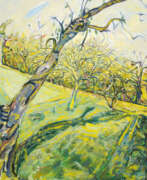

Bernard Chaet was an American artist. Chaet is known for his colorful, dynamic modernist paintings and masterful draftsmanship, his association with the Boston Expressionists, and his 40-year career as a Professor of Painting at Yale University. His works also include watercolors and prints. In 1994, he was named a National Academician by the National Academy of Design. Chaet's works are in the permanent collections of many important museums. Chaet is known for his association as a first generation Boston Expressionist. Having studied with Zerbe, a father of Boston Expressionism, Chaet's early works certainly adhere to the techniques and philosophy of the school.






Ray Austin Crooke was an Australian artist known for for serene views of Islander people and ocean landscapes, many of which are based on the art of Paul Gauguin. He won the Archibald Prize in 1969 with a portrait of George Johnston. His painting The Offering (1971) is in the Vatican Museum collection. Many of his works are in Australian galleries. He was made a Member of the Order of Australia in the 1993 Australia Day Honours, "in recognition of service to the arts, particularly as a landscape artist".


William Glen Crooks, an American neorealist painter, has carved a niche for himself with his unique approach to landscape and urban scene painting. Unlike traditional representations, Crooks' works omit human figures, substituting them with vehicles to embody human traits and emotions. His approach to capturing the essence of city and small-town life through this lens has garnered attention for its depth and thoughtfulness. William Glen Crooks' dedication to his craft began at a young age, evolving from drawing comics to a self-taught mastery in representational painting, driven by a passion to defy the norms of modernism that dominated his formative years. His self-imposed rigorous practice of drawing laid the foundation for his distinctive style.
William Glen Crooks' work has been the subject of several exhibitions, including a notable showcase at the Oceanside Museum of Art (OMA). The exhibition, "The Point of View," marked his first museum exhibition and featured twenty-three paintings that spanned over twenty-five years. These works emphasize cityscapes, nostalgic urban scenery, and expansive landscapes, illustrating Crooks' ability to translate everyday scenes into compelling narratives. His paintings are celebrated for their illumination of light and shadow, transforming landscapes into metaphors that reflect his perceptions of the natural world.
His technique and subject matter draw inspiration from a blend of influences, including the landscape painters of the 1800s, Edward Hopper's narrative style, Mark Rothko's color fields, Wolf Kahn's liberating techniques, and John Frederick Kensett's luminism. This eclectic mix has allowed William Glen Crooks to explore the opacity of light and transparency of shadow in a way that brings a fresh perspective to the landscape genre, making his work resonate with a contemporary audience while retaining a timeless quality.
For collectors and experts in art and antiques, William Glen Crooks offers a unique investment in the realm of contemporary realism. His paintings invite viewers to explore the subtle interplay of light, shadow, and form, capturing the quiet moments of daily life with a profound depth and sensitivity.
To stay updated on William Glen Crooks' latest works and exhibitions, signing up for newsletters from galleries and museums that feature his work, such as the Oceanside Museum of Art, is recommended. This subscription will ensure that enthusiasts are always informed about new sales, auction events, and showcases related to Crooks' evolving portfolio.


Karin Davie is a contemporary artist who lives and works in New York City and Seattle, Washington. Davie is best known for her idiosyncratic twist on the modernist 'stripe' and looping hyperbolic abstractions. Her contemporary practice has been viewed in context with ideas of painting-as-performance from 1950s Abstract Expressionism and the 1960s Op Art.


Juan Manuel de la Rosa is a painter, engraver, and ceramicist known for his works on handmade paper. He studied lesser-known techniques for painting and papermaking from Japan, Egypt, Fiyi and France; his handmade paper is typically made of linen, cotton, or hemp. With these traditional approaches, he creates layers and adds new dimensions to his artworks.


Fernando de Szyszlo Valdelomar was a Peruvian painter, sculptor, printmaker, and teacher who was a key figure in advancing abstract art in Latin America since the mid-1950s, and one of the leading plastic artists in Peru.


David Diao is a Chinese American artist and teacher based in New York City. He first won acclaim and public attention with an exhibition at Paula Cooper Gallery in 1969. He is known for his simplification of form, minimal compositions, and uses of stylized text and typography. Diao's work was included at dOCUMENTA 13. His work is featured in the collection of the Hirshhorn Museum and Sculpture Garden, MoMA, the Whitney Museum of American Art, SFMOMA, Rennes's public council collection, among others. Diao taught at the Cooper Union in the early 70s and was then mostly doing color field painting made by squeegying paint across a large canvas. In 2008 he had his first exhibition in China. In 2012, he was elected into the National Academy of Design. He received a Foundation for Contemporary Arts Grants to Artists award (2015).


Robert Henry Dickerson was an Australian figurative painter and former member of the Antipodeans group of artists. Dickerson is one of Australia's most recognised figurative artists and one of a generation of influential artists who include Ray Crooke, Charles Blackman, Laurence Hope, Margaret Olley and Inge King. Dickerson was a self-taught artist who refused to go to art school. His art has been described as angular and high contrast chiaroscuro and executed in a range of materials including paint, pastels, charcoals and other graphic media. The inspiration for his art came from everyday life and he drew on the themes of loneliness, vulnerability and isolation. Lone characters with long noses and whimsical, often averted eyes featured heavily of his work.


Miodrag Djuric (Montenegrin: Миодраг Ђурић), known as Dado, was an artist born in Montenegro who spent most of his life and creative career in France. He is particularly known as a painter but was also active as an engraver, draftsman, book illustrator and sculptor.


Bertrand Dorny is a French abstractionist artist, painter, printmaker and graphic designer.
Originally a painter, Dorny became interested in various techniques, particularly printmaking, in which he achieved great success and recognition. He created more than 650 engravings.
Dorny enjoyed working with wood and paper, from which he created intricate collages, reliefs, and assembled large wooden panels. He also worked in the field of book collage.


Patrick Dupré is a French op-art and kinetic artist.
While working for the aluminum company Pechiney in Paris in 1964, he created his first work "Skyscraper" on aluminum plate using rubber, ink, sharpener, blade and Shabu knife, and in the 1970s he already developed his own technique of etching on aluminum foil. During the same years, Dupre also invented a new method of industrial engraving on silver, gold and metal bowls. He created art prints by hand, engravings on copperplate, gravure prints and etchings on drypoint. Since 2012, Dupre has produced Op-Art jewelry based on his work and lives in the French countryside.


Klaus Eberlein was a German graphic artist, illustrator and ceramic sculptor. He initially completed training as a chromolithographer. From 1962 to 1968 he attended the Academy of Fine Arts in Munich, and from 1968 he was a master student of Hermann Kaspar, receiving a final diploma from the academy. Eberlein was a member of the Association for Original Etching, the Dachau Artists' Association and the Munich Artists' Association. In 2013 he was accepted into the South German literary association Münchner Turmschreiber.


Nicole Eisenman is French-born American artist known for her oil paintings and sculptures. She has been awarded the Guggenheim Fellowship (1996), the Carnegie Prize (2013), and has thrice been included in the Whitney Biennial (1995, 2012, 2019). On September 29, 2015, she won a MacArthur Fellowship award for "restoring the representation of the human form a cultural significance that had waned during the ascendancy of abstraction in the 20th century."




Erro, real name Guðmundur Guðmundsson, is a contemporary Icelandic painter.
Erro studied painting at the Reykjavik and Oslo Art Academies between 1952 and 1954. He then moved to Italy, where he studied mosaic art in Florence and Ravenna until 1958.
Erro participated in the Venice Biennale in 1986. In 1989 he donated a large part of his works to the Reykjavik Art Museum.
The style of the paintings created by Erro lies on the border between surrealism and pop art. The main theme of his paintings is the depiction of modern civilisation, its technical perfection and its inhumanity. He also uses comic book techniques and science fiction themes in his work.
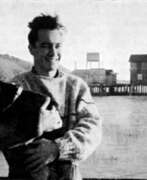

Esteban Fekete was a Hungarian, German, and Argentine painter. He worked and experimented in different techniques - color woodcuts, oil paintings on canvas, wood or organelite. In his paintings we see the world of people, animals and their environment.


Maria Paula Figueiroa Rego was a Portuguese-British visual artist known particularly for her paintings and prints based on storybooks. Rego's style evolved from abstract towards representational, and she favoured pastels over oils for much of her career. Her work often reflects feminism, coloured by folk-themes from her native Portugal.




Ernst Fuchs was an Austrian painter, draftsman, printmaker, sculptor, architect, stage designer, composer, poet, and one of the founders of the Vienna School of Fantastic Realism. In 1972, he acquired the derelict Otto Wagner Villa in Hütteldorf, which he restored and transformed. The villa was inaugurated as the Ernst Fuchs Museum in 1988.


Klaus Fußmann is a contemporary German painter. He studied from 1957 to 1961 at the Folkwang University of the Arts in Essen and from 1962 to 1966 at the Berlin University of the Arts. From 1974 to 2005, he was a professor at the Berlin University of the Arts. His work has won several awards, such as the Villa Romana prize in 1972 and the Art Award of Darmstadt in 1979. Major presentations of his work include exhibitions at the Neue Nationalgalerie in Berlin, 1972; the Mathildenhöhe in Darmstadt, 1982; the Kunsthalle Emden, 1988; the Kunsthalle Bremen, 1992; and the Museum Ostwall in Dortmund, 2003. In 2005 Fußmann completed a monumental ceiling painting in the Mirror Hall of the Museum für Kunst und Gewerbe Hamburg.
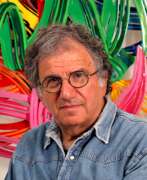

David (Dudu) Gerstein is an Israeli painter, sculptor, draftsman and printmaker.
Gerstein received a broad education: he studied at the Bezalel Academy, then at the École des Beaux-Arts in Paris, in New York he continued his studies at the Art Students League, and in 1974 he received a diploma from St. Martin's School of Art in London. He works freely in all media: printmaking, painting, sculpture, drawing, murals and monumental creations.
In the 1970's Gerstein began experimenting with three-dimensional works, leaving cut-out fragments hanging in space. After many innovations, David began creating wall sculptures made with laser cutting and automotive paint. He created his own kind of pop art and gained an international reputation for his signature style with colorful images of numerous cyclists, butterflies, dancers, runners and more. With the advent of computers, he was able to convert his drawings into perfectly formatted patterns that can be faithfully reproduced in a metalworking shop.
And Gerstein's recognizable monumental sculptures can be seen in cities around the world. His street sculpture Momentum is Singapore's tallest public sculpture.


Franz Gertsch is one of Switzerland's most outstanding contemporary artists. Throughout his career, he has produced a wide range of paintings and graphic works in which he tries to find a particular approach to reality. Although the author uses photographs or slide projections as his starting points, the paintings adhere to a logic of their own which seeks the correctness of all elements. Woodcuts also occupy a special place in Franz Gertsch's work.


Ekkeland Götze is a German painter, printmaker and conceptual artist. After a training as a screen printer he educated himself as an industrial engineer through a correspondence course. Götze painted in his spare time, but he was not allowed to exhibit because of regulations in East Germany - formally he was a printmaker, not a painter. Because of these restrictions he filed an application for an exit permit 1985 which was granted in 1988. In 1989 Götze started to work on a project called "Erde" ("Earth"). He collects soil samples at extraordinary sites of human history around the world and applies them to paper, lime mortar or other backgrounds, making use of a standardized, self-developed technique he calls "terragraphy": He grinds the soil, mixes it with a binder and then applies it making use of a technique similar to screen printing. All backgrounds are square and of identical size. For each site the resulting works of art are given an individual name that reflects the importance of the site. According to Götze, the pictures capture th "spirit and energy" of the place where the soil was gathered. Götze runs a studio in Sendling. He is a member of the Neue Gruppe, an association of Munich artists regularly exhibiting at the Haus der Kunst museum. In 2018 Götze has been awarded the Seerosenpreis, a yearly award assigned to visual artists by the city of Munich.


Kęstutis Grigaliūnas - Lithuanian graphic artist, art teacher. 1988-1989 created linen carvings, wood carvings, screen prints, etchings, illustrated books. Since 1990 one of the first Lithuanian graphic designers to use the color screen printing technique. Made a cut out of cardboard and plywood. It is characterized by a pronounced graphic beginning - lines, signs, ornaments, figurative and abstract motifs are used. Since 1998 creates more complex plastic graphic works and cut-outs, they feature postmodernism features, pop art, Fluxus elements, decorative, eclectic images. A playful mood, irony, and various intellectual references to the images of Lithuania and other cultures and civilizations prevail.


Mariann Grunder, or Susie Mariann Grunder, was a Swiss artist and sculptor. She created large wall reliefs with concrete elements. And her stone sculptures, which often deal with literary or mythological themes, combine elements of surrealism, abstraction and minimalism. Grunder has also done numerous drawings and prints.


Ulrich Hachulla is a German painter and graphic artist, representative of the New Objectivity movement, who lives and works in Leipzig.
He was educated at the Academy of Fine Arts in Leipzig and, in addition to painting, has mastered many graphic techniques.
Hahulla's portraits and self-portraits depict a man in solitude, unsociable, coldly detached - these are numerous types of the respective times. The artist also creates paintings with mythological and allegorical references.


Hans-Uwe Hähn, born in 1955 in Kreuztal, Germany, is a distinguished contemporary German graphic artist, widely recognized for his exceptional contributions to the field of graphic arts. Educated at the Hochschule für Kunst Ottersberg and the Hochschule für Bildende Künste Hamburg, Hähn's career has been marked by an extensive array of solo and group exhibitions, both nationally and internationally. His notable involvement in the art community extends to being a member of Neue Gruppe München and XYLON International – German Section.
Hähn's work is characterized by its intricate exploration of graphic language and the woodcut technique. His artistic practice involves a unique blend of planning and spontaneity, allowing for creative conditions that transcend beyond the mere printing block. His woodcuts, often executed on canvas, are not just about the final print but represent the sum of the process's steps and stages. This approach results in artworks that are rich in transformations and bear a deep connection to the exploration of the linear relationship between feeling and trace. Notable works by Hähn include "Am blinden Kanal VI" and "Am blinden Kanal V," both woodcuts on canvas from 2011.
Hähn's works have been featured in various exhibitions, such as "Revierwechsel" at the Museum für Druckkunst in Leipzig, "Korrespondenzen" at the galerie isabella lanz in Zürich, and "Flug des Erträumten" at Podium Kunst in Schramberg. His artistic contributions have earned him a place in public and private collections, showcasing the reach and impact of his artistic vision.
Collectors, auctioneers, and art experts interested in the works of Hans-Uwe Hähn can stay informed about new product sales and auction events related to the artist by signing up for updates. This service is specifically designed to provide alerts on upcoming sales and events, helping enthusiasts and professionals in the field of art and antiques to remain connected with the latest developments in Hähn's artistic journey.


Robert Hammerstiel, an Austrian painter and engraver born on 18 February 1933 in Vršac, Yugoslavia, was renowned for his profound and impactful art. His works, deeply influenced by his experiences, were widely exhibited in prominent cities like New York, Vienna, Cairo, and Brussels.
Hammerstiel's journey in the art world was notable for its depth and variety. In 1988, he transitioned to a full-time artistic career, leaving behind his work in the steel industry. This shift marked a new phase in his life, allowing him to fully dedicate himself to his art. One of his significant works includes "Von Ikonen und Ratten: Eine Banater Kindheit 1939 – 1949," which comprises 32 woodcuts, highlighting his skill in both writing and visual arts. His talent was recognized with several prestigious honors, including the Austrian Decoration for Science and Art in 1998 and the Austrian State Prize for Graphics in 1973.
Hammerstiel's art was not just limited to traditional formats; in 2007, he impressively wrapped the Ringturm in Vienna with a 4,000 square meter painting. His works are a part of various collections and have been displayed in significant exhibitions. Notably, the Leopold Museum in Vienna featured his graphic work in an exhibition titled "Winterreise", inspired by Schubert's song cycle, showcasing a series of drawings and woodcuts.
Robert Hammerstiel's influence in the art world extended beyond his lifetime, culminating in his birth town dedicating a museum to his works in 2010. His passing on 23 November 2020 marked the end of an era but left behind a rich legacy that continues to inspire artists and art lovers globally. His work is a testament to the power of art in expressing the complexities of human experiences and emotions.
For collectors, auctioneers, and experts in art and antiques, the works of Robert Hammerstiel offer a unique blend of cultural richness and profound artistic expression. His art, characterized by its emotional depth and technical skill, continues to hold a special place in the world of fine arts.
To stay informed about exhibitions, sales, and auction events related to Robert Hammerstiel's art, sign up for updates. This subscription will keep you updated on new opportunities to engage with the work of this influential Austrian artist.


Burkhard Held is German painter living and working in Berlin, Germany. His art is based on figuration dissolving into abstraction. In 1993 he became professor at the Berlin University of the Arts and later served as a professor at the China Academy of Art in Hangzhou, PRC. Burkhard Held is a figurative painter, who dissolves his motifs – landscapes, portraits, flowers – into color fields with a strong tendency towards autonomy. His strongly colored all-over images reinterpret things as abstract and then lead the back into figuration. In 2009 Held started to dedicate himself to the subject of flowers: blossoms become compositions with a landscape character, and are distributed in equally strong colors across the canvas.


Gussy Erika Edith Hippold-Ahnert, née Ahnert, was a German painter and master student of Otto Dix. The early work of the Dix student, such as the painting Lying Nude from 1931, shows her closeness to Dix's New Objectivity or Verism. She reached her artistic peak in 1932/1933, when she developed a painting style of her own, unmistakable character in the glazing technique taught by Dix. Hippold-Ahnert's late work is closely connected to the works of her husband Erhard Hippold and other artists of this region and time.


Veit Hofmann, born in 1944, is a distinguished German artist, renowned for his printmaking and painting. His artistic journey began with an apprenticeship as a printer, followed by studies at the Academy of Fine Arts in Dresden from 1967 to 1972, where he was mentored by Professors Gerhard Kettner and Herbert Kunze. Post-graduation, Hofmann embarked on a freelance career, forging close relationships with fellow artists Max Uhlig, Helge Leiberg, and Stefan Plenkers.
Hofmann's work is characterized by its vibrant colors and dynamic compositions, often oscillating between abstraction and figuration. His artistic repertoire includes a significant number of solo exhibitions and contributions to various group shows, notably participating in the Kunstausstellungen der DDR in 1982/1983 and 1987/1988.
Throughout his career, Hofmann has displayed his art in numerous galleries and exhibitions, including at the Museu National in Brasilia with "Horizontbeobachter" and the Neue Sächsische Galerie in Chemnitz with "Luftreise." These exhibitions highlight his versatility and the international recognition of his work.
For collectors, auctioneers, and experts in art and antiques, Hofmann's creations offer a unique blend of traditional techniques and contemporary expression. His pieces not only represent an essential part of German postwar and contemporary art but also provide insights into the cultural and artistic movements of the time.
For those interested in the evolving world of art and the works of Veit Hofmann, staying updated with the latest exhibitions and sales is crucial. Subscribing for updates ensures that enthusiasts and professionals alike don't miss out on new opportunities related to this influential artist.


















